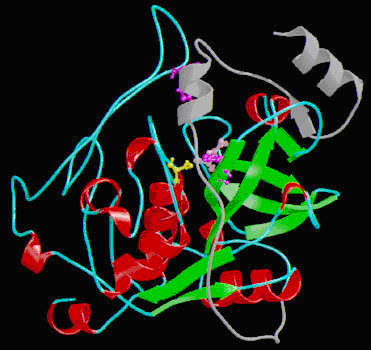To get started:
- Click the edit this page tab at the top. Save the page after each step, then edit it again.
- Click the 3D button (when editing, above the wikitext box) to insert Jmol.
- show the Scene authoring tools, create a molecular scene, and save it. Copy the green link into the page.
- Add a description of your scene. Use the buttons above the wikitext box for bold, italics, links, headlines, etc.
More help: Help:Editing
For more help, look at this link:
http://www.proteopedia.org/wiki/index.php/Help:Getting_Started_in_Proteopedia
Cathepsin B
This is my new image.  Cathepsin B is a very complex protein which is a part of the super family of papain-like cysteine proteases. These papain-like cysteine proteases are abundant in nature and can be found in baculovirus, eubacteria, yeast, plants, and animals. They are synthesized as inactive pro-enzymes with N-terminal pro-peptide regions. The pro-peptide plays an important role as an inhibitor of enzymatic activity. A number of cysteine proteases are located within lysosomes and they have very specific functions in endo and exopeptidase activity. Cathepsin B is synthesized as a pre-proenzyme of 339 amino acid residues and it can act as an endopeptidase. Its activity is inhibited by a2-macroglobulin. The most crucial functions of Cathepsin B are that it is implicated in the turnover of proteins and carries out different roles in maintaining the normal metabolism of cells. Cathepsin B is found in humans and other mammals and it is encoded by a single gene and this gene exhibits a high degree of sequence homology to other cysteine proteases of the papain super family. However, in parasitic helmiths and free-living nematodes, the cathepsin B genes can be seen as large multigene families instead of just one single gene shown in humans and mammals. The function of this cathepsin B gene has not been verified for sure, but research is showing that cathepsin B could be involved in induction of protective immunity. In diseases, such as cancer and arthritis, Cathepsin B gene shows up regulation and in Alzheimer’s disease down regulation is shown.
Cathepsin B is a very complex protein which is a part of the super family of papain-like cysteine proteases. These papain-like cysteine proteases are abundant in nature and can be found in baculovirus, eubacteria, yeast, plants, and animals. They are synthesized as inactive pro-enzymes with N-terminal pro-peptide regions. The pro-peptide plays an important role as an inhibitor of enzymatic activity. A number of cysteine proteases are located within lysosomes and they have very specific functions in endo and exopeptidase activity. Cathepsin B is synthesized as a pre-proenzyme of 339 amino acid residues and it can act as an endopeptidase. Its activity is inhibited by a2-macroglobulin. The most crucial functions of Cathepsin B are that it is implicated in the turnover of proteins and carries out different roles in maintaining the normal metabolism of cells. Cathepsin B is found in humans and other mammals and it is encoded by a single gene and this gene exhibits a high degree of sequence homology to other cysteine proteases of the papain super family. However, in parasitic helmiths and free-living nematodes, the cathepsin B genes can be seen as large multigene families instead of just one single gene shown in humans and mammals. The function of this cathepsin B gene has not been verified for sure, but research is showing that cathepsin B could be involved in induction of protective immunity. In diseases, such as cancer and arthritis, Cathepsin B gene shows up regulation and in Alzheimer’s disease down regulation is shown.
Structure
The structure of cathepsin B.
Function
Mechanism of Action
Medical Implications or Possible Application
References
|

